
Chinese mythology is mythology that has been passed down in oral form or recorded in literature in the geographic area now known as Greater China. Chinese mythology includes many varied myths from regional and cultural traditions. Much of the mythology involves exciting stories full of fantastic people and beings, the use of magical powers, often taking place in an exotic mythological place or time. Like many mythologies, Chinese mythology has in the past been believed to be, at least in part, a factual recording of history. Along with Chinese folklore, Chinese mythology forms an important part of Chinese folk religion. Many stories regarding characters and events of the distant past have a double tradition: ones which present a more historicized or euhemerized version and ones which present a more mythological version.

Lanzhou is the capital and largest city of Gansu Province in Northwest China. Located on the banks of the Yellow River, it is a key regional transportation hub, connecting areas further west by rail to the eastern half of the country. Historically, it has been a major link on the Northern Silk Road and it stands to become a major hub on the New Eurasian Land Bridge. The city is also a center for heavy industry and petrochemical industry.

The Dragon King, also known as the Dragon God, is a Chinese water and weather god. He is regarded as the dispenser of rain, commanding over all bodies of water. He is the collective personification of the ancient concept of the lóng in Chinese culture.
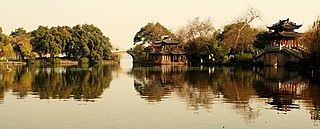
West Lake is a freshwater lake in Hangzhou, China. It is divided into five sections by three causeways. There are numerous temples, pagodas, gardens, and natural/artificial islands within the lake. Gushan (孤山) is the largest natural island and three artificial islands: Xiaoyingzhou (小瀛洲), Huixin Pavilion (湖心亭), and Ruan Gongdun (阮公墩) stand at the middle of the lake. Leifeng Pagoda (雷峰塔) and Baochu Pagoda (保俶塔) are separated by the lake. Mirroring each other, the basic pattern of "one mountain, two towers, three islands, three banks, and five lakes" is formed.
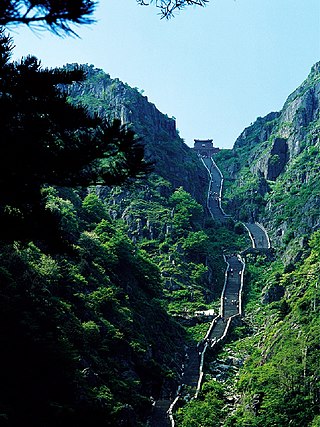
Mount Tai is a mountain of historical and cultural significance located north of the city of Tai'an. It is the highest point in Shandong province, China. The tallest peak is the Jade Emperor Peak, which is commonly reported as being 1,545 meters (5,069 ft) tall.

Mount Lao, or Laoshan, is a mountain located near the East China Sea on the southeastern coastline of the Shandong Peninsula in China. The mountain is culturally significant due to its long affiliation with Taoism and is often regarded as one of the "cradles of Taoism". It is the highest coastal mountain in China and the second highest mountain in Shandong, with the highest peak (Jufeng) reaching 1,132.7 metres (3,716 ft). The mountain lies about 30 kilometres (19 mi) to the northeast of the downtown area of the City of Qingdao and is protected by the Qingdao Laoshan National Park that covers an area of 446 square kilometers.
Wang Chong, courtesy name Zhongren (仲任), was a Chinese astronomer, meteorologist, naturalist, philosopher, and writer active during the Han Dynasty. He developed a rational, secular, naturalistic and mechanistic account of the world and of human beings and gave a materialistic explanation of the origin of the universe. His main work was the Lunheng. This book contained many theories involving early sciences of astronomy and meteorology, and Wang Chong was even the first in Chinese history to mention the use of the square-pallet chain pump, which became common in irrigation and public works in China thereafter. Wang also accurately described the process of the water cycle.
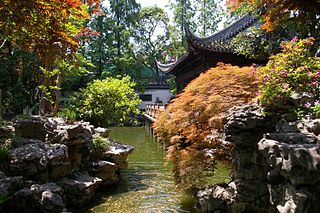
The Chinese garden is a landscape garden style which has evolved over three thousand years. It includes both the vast gardens of the Chinese emperors and members of the imperial family, built for pleasure and to impress, and the more intimate gardens created by scholars, poets, former government officials, soldiers and merchants, made for reflection and escape from the outside world. They create an idealized miniature landscape, which is meant to express the harmony that should exist between man and nature.

Hanshan Temple, is a Buddhist temple and monastery in Gusu District of Suzhou, Jiangsu, China. It is located at the town of Fengqiao, about 5 kilometers (3.1 mi) west of Suzhou's old city.

Mount Jiuhua located in Chizhou, Anhui Province in China is an important Buddhist site and natural scenic spot. It is one of the four famous Buddhist mountains in China, one of the first batch of 5A level scenic spots in China, one of the first batch of natural and cultural heritage sites in China, and the main scenic spot of "two mountains and one lake" tourism development strategy in Anhui Province. The planned area of the scenic spot is 120 square kilometers, and the protected area is 174 square kilometers, which is composed of 11 scenic spots.
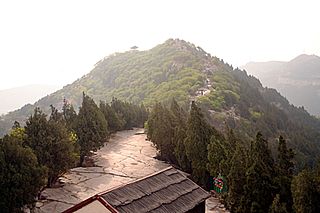
The Thousand Buddha Mountain is a hill located about 2.5 kilometers southeast of the city of Jinan, the capital of Shandong Province, China. It covers 1.518 square kilometers and has a peak of 285 meters (935 ft) above sea level. It is renowned for its numerous Buddha images which have been carved out of the hill's rock faces or free-standing structures erect since the times of the Sui dynasty (581–618) and its Xingguochan Temple. It is considered one of the "Three Greatest Attractions in Jinan" together with Baotu Spring and Daming Lake. It is also one of the 4A-rated Tourist attractions in China. Thousand Buddha Mountain is opened up as a public park in 1959, rated as AAAA-rated Tourist Attractions of China in 2005, and rated as National Park of China in March 2017.

Sacred mountains are central to a certain religions, and are usually the subjects of many legends. For many, the most symbolic aspect of a mountain is the peak because it is believed that it is closest to heaven or other religious realms. Many religions have traditions centered on sacred mountains, which either are or were considered holy or are related to famous events. In some cases, the sacred mountain is purely mythical, like the Hara Berezaiti in Zoroastrianism. Mount Kailash is believed to be the abode of the deities Shiva and Parvati, and is considered sacred in four religions: Hinduism, Bon, Buddhism, and Jainism. Volcanoes, such as Mount Etna in Italy, were also considered sacred, Mount Etna being believed to have been the home of Vulcan, the Roman god of fire and the forge.
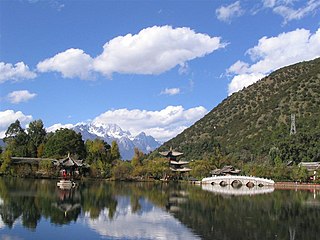
Black Dragon Pool is a famous pond in the scenic Jade Spring Park located at the foot of Elephant Hill, a short walk north of the Old Town of Lijiang in Yunnan province, China. It was built in 1737 during the Qing dynasty and offers views of the region's tallest mountain, Jade Dragon Snow Mountain, over its white marble bridge.

The Temple of the Earth in Beijing, China, is located in the northern part of central Beijing, around the Andingmen area and just outside Beijing's second ring road. It is also located just a few hundred yards north of Yonghe Temple. At 42.7 hectares, it is the second largest of the four Temples of Beijing behind only the Temple of Heaven.
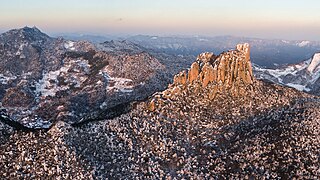
Pujiang is a county of Zhejiang, China. It is under the administration of Jinhua city.

Mengding Ganlu or Ganlu tea is a tea from Meng Mountain, Sichuan Province in the southwest part of China. Meng Shan is reputed to be the place where tea was first cultivated. Mengding Ganlu means "Sweet Dew of Mengding" where Mengding refers to "the top of Meng Shan".
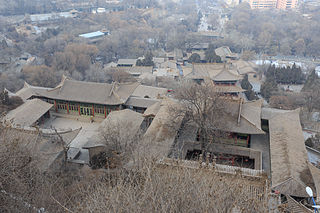
Wuquan Mountain is a mountain in southern Lanzhou in Gansu, China. It lies to the north of Gaolan Mountain (皋兰山). According to legend, the famous Western Han general Huo Qubing once led his forces here. They were very thirsty but could not find any water, so Huo slammed his horsewhip into the ground five times, and five springs appeared. This is the origin of the name Wuquan Mountain.
Twelve Views of Bayu are popular scenic views in and around the city of Chongqing, China. Ba and Yu are old names of Chongqing in Imperial times. Influenced by Eight Views of Xiaoxiang in Hunan Province, people in Chongqing listed their own most beloved views during the reign of the Tianshun Emperor of the Ming dynasty. Scenic views in the list changed throughout the history. Some scenic views appeared in earlier lists no longer exist in modern days due to the change of physical geography, landscapes and land-uses.

The Wǔfāng Shàngdì, or simply Wǔdì or Wǔshén are, in Chinese canonical texts and common Chinese religion, the fivefold manifestation of the supreme God of Heaven. This theology dates back at least to the Shang dynasty. Described as the "five changeable faces of Heaven", they represent Heaven's cosmic activity which shapes worlds as tán 壇, "altars", imitating its order which is visible in the starry vault, the north celestial pole and its spinning constellations. The Five Deities themselves represent these constellations. In accordance with the Three Powers they have a celestial, a terrestrial and a chthonic form. The Han Chinese identify themselves as the descendants of the Red and Yellow Deities.
Chinese auspicious ornaments in textile and clothing refers to any form of Chinese auspicious ornaments, which are used to decorate various forms of Chinese textile and clothing, fashion accessories, and footwear in China since the ancient times. Chinese auspicious ornaments form part of Chinese culture and hold symbolic meanings. In ancient China, auspicious ornaments were often either embroidered or woven into textile and clothing. They are also used on religious and ritual clothing and in Xifu, Chinese opera costumes. Auspicious symbols and motifs continue to be used in present day China in industries, such as home textiles and clothing; they are also used in modern design packaging and interior design. Some of these Chinese auspicious ornaments were also culturally appropriated by European countries during the era of Chinoiserie, where they became decorative patterns on fashionable chinoiserie fashion and textiles.
















